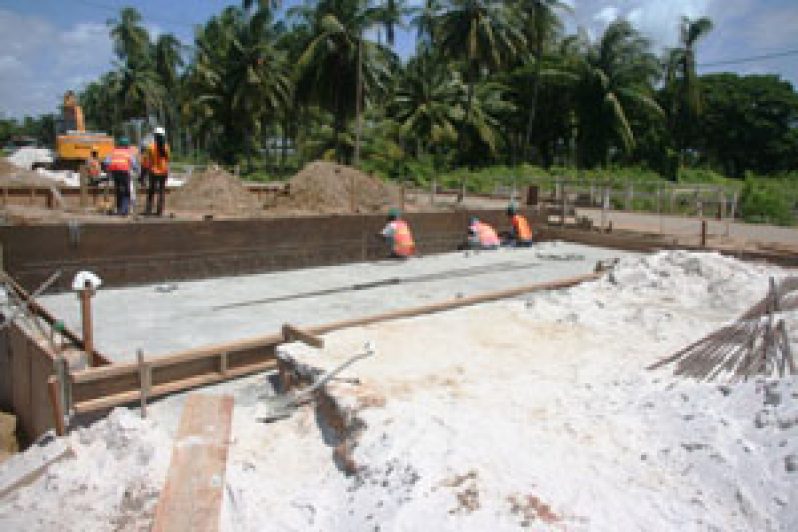MINISTER of Public Works, Robeson Benn on Wednesday began another round of visits to major civil engineering projects, now that the weather has improved somewhat to make sure that contractors are moving apace and the work is of good quality.
 He acknowledged that there have been criticisms about the pace of work which has been affected by the extended period of rainfall with the rainy season going into July. There were also challenges with the supply of materials such as crusher run, aggregate and materials from the quarries.
He acknowledged that there have been criticisms about the pace of work which has been affected by the extended period of rainfall with the rainy season going into July. There were also challenges with the supply of materials such as crusher run, aggregate and materials from the quarries.
“We hope that those issues are largely behind us and that we could move forward efficiently… so I’m calling on all the contractors, engineers, supporting consultants, ministry staff and utility owners to work together to achieve projects on time so that we give the best service that we can to the public,” Benn emphasised.
With regards to the sea defence project in Georgetown he stressed on the cost effectiveness of the structure. While there has not been a recurrence of the high tides, the hurricane season has started which may cause surges in the sea that can arrive on the Guyana coast. “So we are monitoring the situation and we are on the lookout for those to be able to respond as much as possible,” the minister said.
In relation to the social gatherings on the sea wall along the northern carriageway, Benn stressed that there will be no liming on the sea wall because it has destroyed the embankment.
“The so called lime will move back to the west where there is space, where there are no people living nearby, where the frolic could continue without much disturbance to the greater public,” he said.
The minister is also urging people who are encumbering the road sides to remove their vehicles and stalls.
Sea Defence
Senior District Engineer, Maitland Stewart, in explaining the project being done on the sea wall, noted that the ministry came up with the wall design (a strobe wall) and before that, studies were done on the wave activity. “It wasn’t a case where the wave broke over the wall, it was collapsing on the wall so we realised that building a short strobe wall (0.7 meters high) would be enough, not to completely prevent the overtopping, but to reduce that amount of overflow,” he said.
Further, the Force Account Unit, which is executing the project, intends to do a one-kilometre stretch of the strobe wall which will extend from Liliendaal (from the Ministry of Health Building) to Conversation Tree, and even a little further up heading to Sheriff Street.
The project is costing the ministry $19,000 per metre as against the use of rock/boulder alternative which would cost $400,000 per metre. One of the initial considerations for the initiative was placing boulders about four metres out, and then sloping them onto the fore-shore.
Stewart explained that while the use of the boulders is good for breaking the wave energy, there are a lot of voids between the rocks so when the water reaches the rocks it dissipates almost immediately; thereby avoiding the run-up that causes the overtopping.
“A plus for us is that we noticed that the foreshore is starting to build up back…we estimate that within the next six months or so we would have more control of this phenomenon,” Stewart noted.
While there have been concerns with the added weight on the sea-wall, it was noted that several prototypes were tested and compared with the soil conditions and strength. It was then determined that a light weight cement/concrete with an incorporation of sea shells was used to control the weight of the structure.
Some of the other works being done in the district include the maintenance and repairs to sea defences and river embankments on the coast and riverine areas. These are also being carried out by the Force Account Unit. Additionally, continuous monitoring is done by rangers.
Bridges
The minister also visited two bridge projects at Kingelley and Tempe on the West Coast of Berbice, Region 5 where he interacted with the workers and viewed the progress being made.
Project Manager, Sunil Ganesh explained that the contract which includes six projects was awarded to Kares Engineering valued US $2.6 M.
“The works include the construction of 11 structures of which six are culverts and five are bridges,” he said. Of the six projects two are at Coverden and Soesdyke on the East Bank of Demerara and the remainder is in West Coast Berbice.
With regards to the bridge at Kingelley, Ganesh indicated that the project is 75 percent completed. “We are on schedule to complete on time,” he emphasised.
These works are expected to enhance drainage within West Coast Berbice and also promote permanent accessibility along the route. (GINA).



.jpg)








